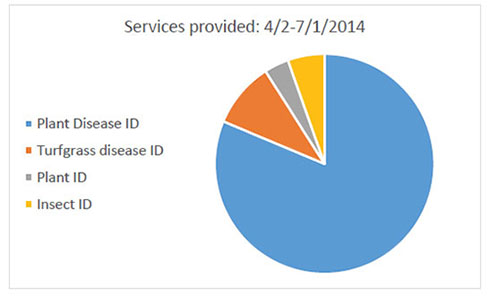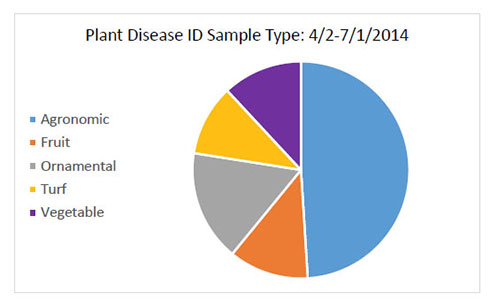Taking an environmentally sensitive approach to pest management
Plant Diagnostic Clinic Update
Published: July 15, 2014
The Plant Diagnostic Clinic has been re-opened for 2 months now. It has been a whirlwind of activity and a lot of learning on my part. I am grateful for all the assistance I’ve received from specialists in the Division of Plant Sciences and University of Missouri Extension. This write up highlights fruit, vegetable, ornamental and turf samples submitted. Two graphs are included to show the activity in the Plant Diagnostic Clinic thus far (Figure 1 and Figure 2).

Figure 1: Services requested at the PDC.

Figure 2: Types of plants submitted to the clinic for disease identification.
Fruits and Vegetables
There have been several issues diagnosed on fruit samples. Winter injury was reported in both blackberry and blueberry. There has been some chemical injury reported on blueberry, blackberry, apple, pear and cherry due to drift from neighboring fields, accidental sprays from the grower or misapplication of fertilizer causing a phytotoxicity. Reporting on diseases, this spring has been a big fire blight year across the state of Missouri. The spring weather was perfect for this. Walking around the MU-Columbia campus there isn’t a Bradford pear tree that isn’t affected. For fruit-producing and ornamental trees, affected by fire blight, pruning is recommended. The MU-Extension publication, G6020, on fire blight is useful to learn about the disease and recommendations (http://extension.missouri.edu/p/g6020). Other disease issues include:
A handful of vegetable samples have been submitted, mostly tomatoes. Many of these have had chemical injury. Chemical injury has also been diagnosed on spaghetti squash and potato. The most common injuries are due to a growth regulator herbicide. In some cases the grower used an herbicide between rows or in close proximity. However, in most of the cases the grower is positive they have not made an herbicide application. During the investigation, the source of damage is commonly the compost or manure used in the soil. Many growers don’t think about the potential of herbicide carryover in manure or compost (straw, grass clippings or even wood chips). There is an article from a MU extension specialist (http://extension.missouri.edu/nwregion/hort/current/herbicide.shtml) and an article from North Carolina State University (http://www.ces.ncsu.edu/fletcher/programs/ncorganic/special-pubs/herbicide_carryover.pdf) that covers this topic. Diseases and issues diagnosed are listed below:
| Crop | Disease / Pest / Issue |
|---|---|
| Garlic | Bacterial soft rot |
| Tomato | Bacterial canker Bacterial stem rot Undetermined virus Gray mold Pythium root rot White mold Southern blight Frost injury Physiological leaf roll Juglone toxicity |
Ornamentals
A number of cases of winter injury on ornamentals was diagnosed this spring. Many woody ornamentals were already stressed going into winter from the 2013 drought. A reminder that when the weather is hot and dry, supplemental watering to woody ornamentals is recommended. The common story with the evergreens is, they stayed green all winter long and when temperatures warmed up dieback was noticed. Green tissues turned brown practically overnight, or so it seems. The reason is that evergreens do not go into complete dormancy during the winter. During warm, sunny days the plants are still biologically active, reduced but still transpiring and using water. If the plants don’t have enough water stored in their roots or if the ground is frozen making water unavailable, they become stressed. Since biological activity is reduced the plants will retain their green color. However, once the weather warms up and the plants go back to their full photosynthetic potential the dead parts are quickly abscised (cut off from receiving any water or nutrients), leaving branches, leaves or needles yellow and unaesthetically pleasing. The dead branches should be pruned as they can attract bark beetles or other insects. Plant species diagnosed with winter / cold injury include arborvitae, blue atlas cedar, pines (white pine the most prevalent), rhododendron and a tulip tree. There has also been a number of chemical injuries, which include drift from neighboring agronomic fields or misapplications by the homeowner or landscaping company. Plant diseases and pests diagnosed include:
Turfgrass
Turfgrass samples have been submitted from golf courses, parks, schools and lawns. The majority of these samples have come from golf putting greens, due to their need for intensive and aggressive management practices. Submitted plant species included creeping bentgrass, fescue, Kentucky bluegrass, and Zoysia grass. The diseases and issues are listed below:
Subscribe to receive similar articles sent directly to your inbox!
REVISED: September 29, 2015